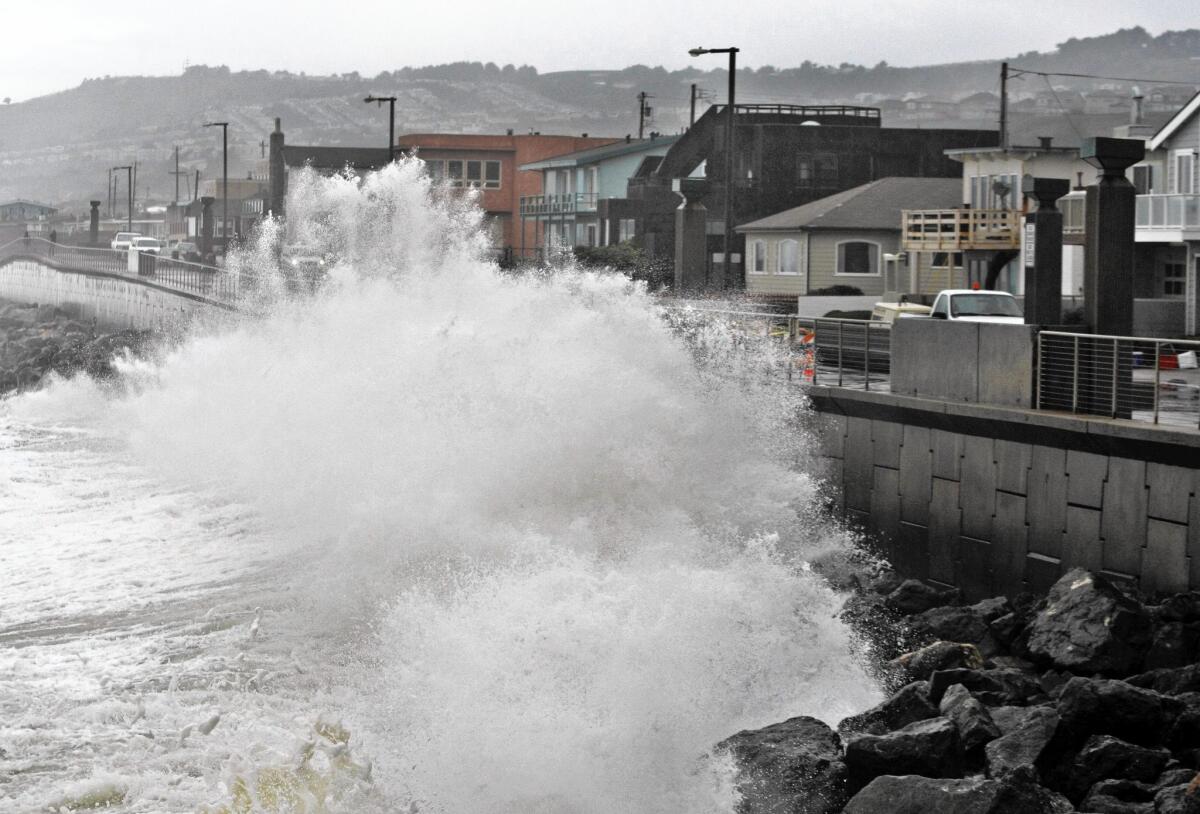Sea levels will rise, experts warn, and ‘it’s not going to stop’

Waves pound a sea wall in Pacifica, Calif., in 2010. Sea levels off the West Coast have been depressed in recent years because of a weather pattern that has lowered ocean temperatures, scientists say. But that is due to reverse.
- Share via
Here’s one trend California is behind on: rising sea levels.
For the last 23 years, ocean levels around the world have climbed by about 3 inches on average, and NASA scientists say the sea will continue to rise as warming temperatures cause ice sheets in Greenland and Antarctica to melt.
But California, and the rest of the western United States, has actually seen ocean levels fall. That’s about to change, thanks to a shift in weather patterns, and scientists are sounding the alarm.
New satellite measurements from NASA suggest that ocean levels could rise by 3 feet or more globally by the end of the century. The question faced by scientists and policymakers is not whether oceans will rise, but how fast and by how much.
“People need to be prepared for sea level rise,” said Joshua Willis, an oceanographer at NASA’s Jet Propulsion Laboratory in La Cañada Flintridge. “It’s not going to stop.”
If ocean levels are rising, where is the additional water coming from?
Steve Nerem, a scientist at the University of Colorado, Boulder, said that about one-third of the rising sea level is a result of the ocean expanding as it absorbs heat trapped by greenhouse gases and becomes warmer. Another third comes from melting glaciers, and the rest comes from the melting of enormous ice sheets in Greenland and Antarctica.
How much ice is actually melting in Greenland and Antarctica?
During the last decade, Greenland’s ice sheet lost about 303 gigatons of ice on average each year, while Antarctica’s ice sheet lost about 118 gigatons annually on average. One gigaton is a billion metric tons.
Why did California’s sea level fall during the last few decades?
Waters off the coast of the western U.S. have had lower surface temperatures, largely because of the Pacific Decadal Oscillation, or PDO. This pattern of wind, ocean current and temperature variations can bring warm or cold phases for several years — or even decades. Since 1998, some scientists say, we have experienced a cold phase that has counteracted the effects of climate change and prevented sea levels from rising.
Will California’s sea levels always be lower than elsewhere?
No, and scientists say a reversal in the Pacific Decadal Oscillation could cause sea levels to catch up to increases seen elsewhere. According to JPL’s Willis, current measurements indicate that a switch in the PDO already occurred. “We can expect accelerated rates of sea level rise along this coast over the next decade as the region recovers from its temporary sea level ‘deficit,’ ” he said.
Does this have anything to do with El Niño?
Yes. Some climatologists think of El Niño as a short-term phenomenon that lies on top of the more long-term temperature fluctuations associated with the Pacific Decadal Oscillation. Warmer PDOs are more conducive to El Niños.
What are we supposed to do about rising sea levels?
The key word stressed by scientists: planning. Tom Wagner, cryosphere program manager for NASA, said communities along coastal zones should factor in the increase in sea levels when considering major infrastructure projects such as a water treatment plant or power plant. Rising sea levels could mean more erosion or flooding associated with a storm surge, he said.
What’s the likelihood that sea levels stay the same or actually fall?
Don’t count on it. Over the next century, the sea may rise between 1 1/2 and 3 feet or possibly more, said Eric Rignot, a research scientist at JPL and a professor at UC Irvine. And ice sheets react to warming by melting faster and faster. Any reversal of the inevitable ice melt “would take centuries,” he said. “Some of the measurements collected by NASA are an important red flag on what’s about to come.”
Twitter: @MattHjourno
Hoy: Léa esta historia en español
ALSO:
Patients have no need to fear sleepy surgeons, study finds
Stephen Hawking says he’s solved a black hole mystery, but physicists await the proof
What the dust in your house reveals about you







